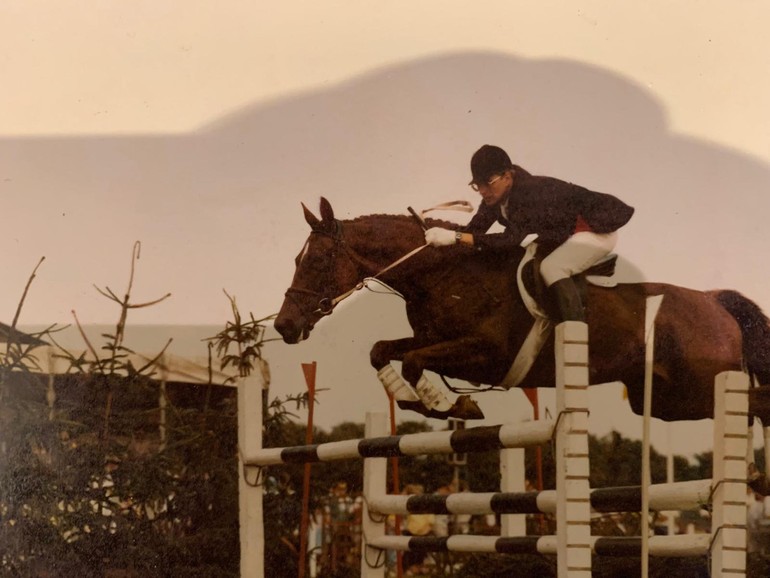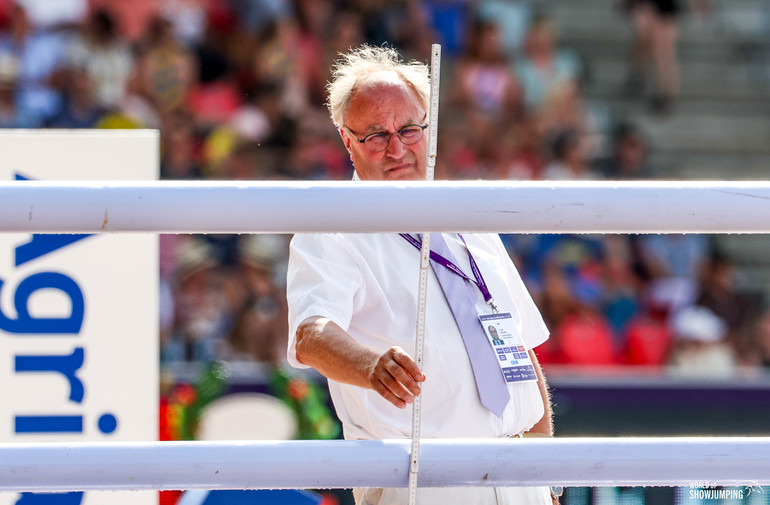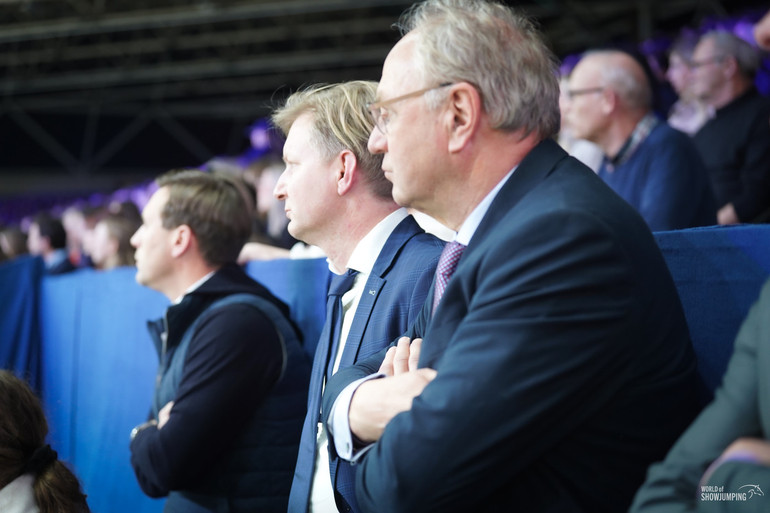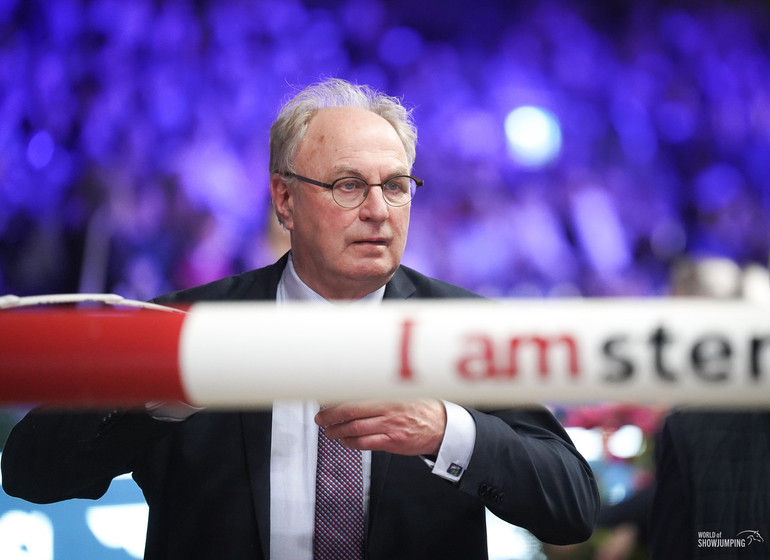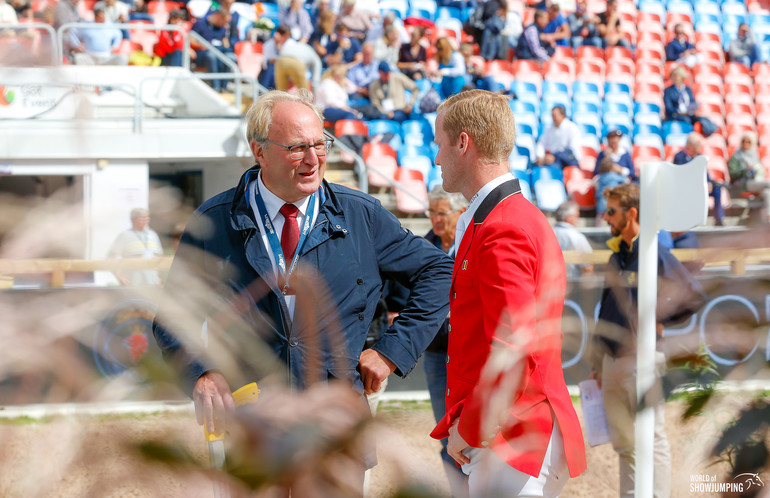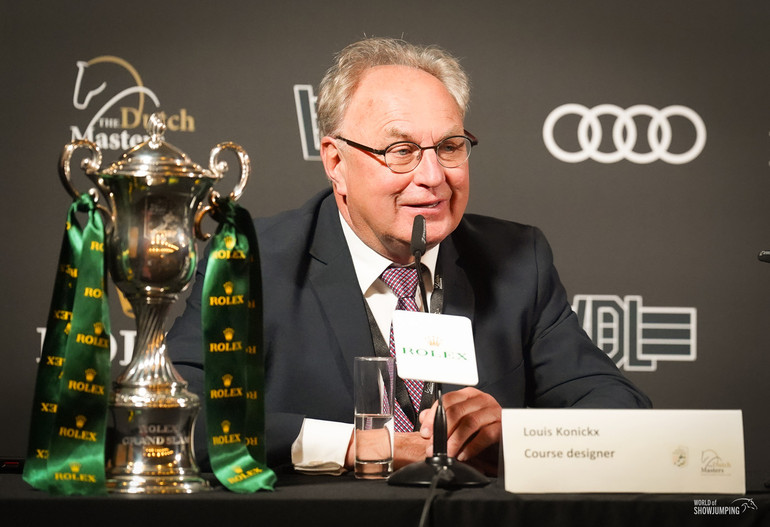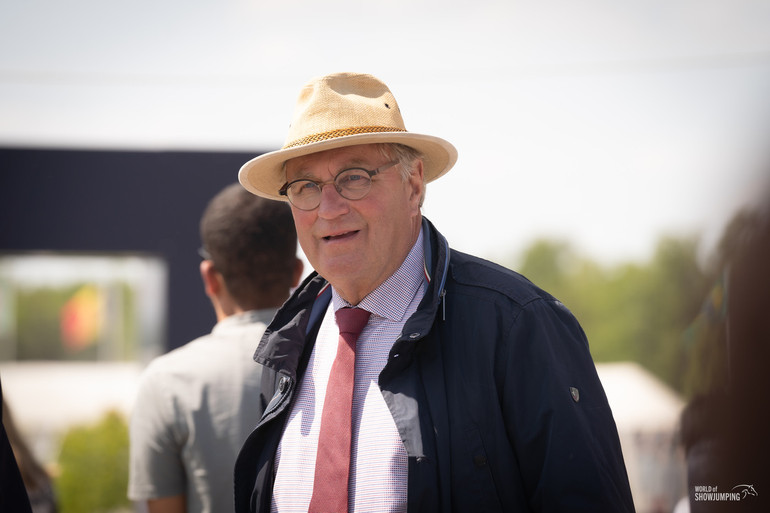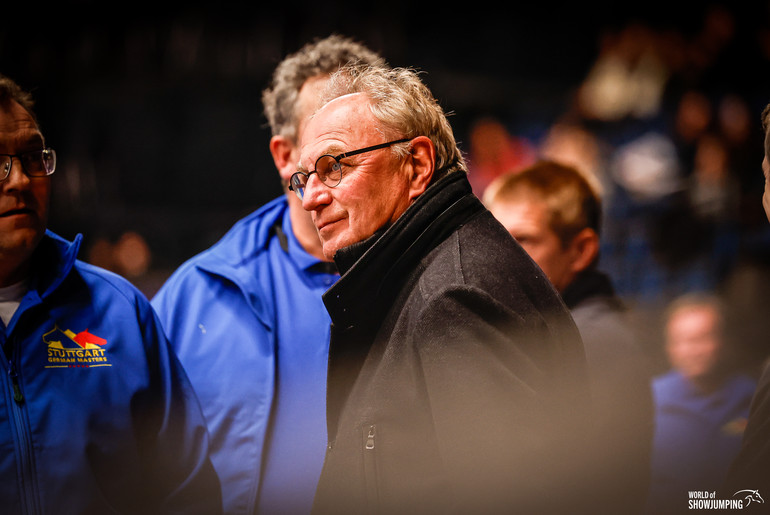 "I get great joy from my role as a course designer, being a member of an operational team and expressing my creativity in this environment – and that is for me far more interesting than earning money," Dutch course designer and FEI Jumping Committee member Louis Konickx tells WoSJ. Photo © Jenny Abrahamsson/WoSJ.
"I get great joy from my role as a course designer, being a member of an operational team and expressing my creativity in this environment – and that is for me far more interesting than earning money," Dutch course designer and FEI Jumping Committee member Louis Konickx tells WoSJ. Photo © Jenny Abrahamsson/WoSJ.
Text © World of Showjumping
“It would be good if there was a stronger feeling of commitment and shared responsibility between the FEI and its stakeholders,” Dutch course designer and FEI Jumping Committee member Louis Konickx tells World of Showjumping. “From an official's point of view, it often seems that the sport is merely run by the rule book. However, sport and sportsmanship is far more than a rule book and has everything to do with communication and common sense – not to forget passion and fun. There could be more trust in people and confidence in the decisions that are being made. Of course, with the increased amount of money and interests involved in our sport, there's more pressure from the legal side. However, this also means that these days, we forget to really think and communicate.”
Sport and sportsmanship is far more than a rule book and has everything to do with communication and common sense – not to forget passion and fun
Despite his illustrious career as a course designer, the 70-year-old – who has a resume only a few can match, with Olympic Games, numerous championships and multiple major events included – does not think of himself as a professional within the equestrian industry. “I have kept myself a little bit on the side-lines,” Konickx tells. “I have never felt like someone who is dependent on the jumping world. I get great joy from my role as a course designer, being a member of an operational team and expressing my creativity in this environment – and that is for me far more interesting than earning money.”
From football to horses and psychology
Konickx, who earned a living as a consultant, as well as a project leader at the University of Nijmegen, still refers to course design as a hobby – an interest that started in his childhood. “I was playing soccer with my friends in our village when one day, a girl rode past us on a horse,” he recalls about the very beginning of his infatuation with horses. “It looked amazing; horses seemed far more interesting than running behind a ball. My father – who was a photographer – knew some people within equestrian sports, so it was quite easy for me to start riding. However, I had to earn money for the lessons at the local riding school by working in the fields.”
Horses seemed far more interesting than running behind a ball
Later on, Konickx moved to study psychology at the University of Nijmegen. Working alongside his studies, he bought a horse to keep his riding hobby going. “I'm not sure I had the most talent,” he laughs. “There was a course designer in our area and as it was not easy to ride his courses, he received some criticism. In his response, he said that I should try doing the courses myself – and I accepted the challenge.”
Course design quickly escalated into another dear hobby for Konickx. “A very important aspect for the progress of my course designing career was when I, in 1998, was asked by Arno Gego to help in Valkenswaard at Jan Tops and Alfonso Romo's international events. All the big names of the time were officiating there – at the venue that is now called the Longines Tops International Arena – and I got to be their assistant. This way, I was given the opportunity to work with all the famous course designers from all over the world – from Leopoldo Palacios to John Doney and Conrad Homfeld. That was actually my introduction to this world. After my psychology studies, I have worked as a consultant for several companies, and more recently also for the University of Nijmegen, focused on projects exploring human relations. Luckily, I have had a lot of freedom and have been able to spend most of my free time at shows as a course designer. It has been a nice mix for me.”
The difference between course building and course design
“I like to emphasize the difference between course building and course design,” Konickx points out when we move on to speak about the philosophy behind his work. “Course building is about the technical knowledge; all the things you should know and your competence to survive in the industry of one-, two- and three-star events. First of all, you have to build courses that are fit to the level of the competitors. Also, you have to respect the time table. At many shows, sticking to the schedule is actually the most important thing. When you have many courses in a small arena during multiple days, the variety of the courses built is naturally limited.”
I prefer it when horses come out calmer than they went in, that everybody comes out with a good feeling
“For real course design, there are opportunities at some special events, four and five-star competitions and championships," he continues. “Then you can put your creativity into use and have special courses for the occasion. At these shows, you can focus on special lines, the variety of obstacles and decorations. These kind of jobs give more as there is far more richness. Course building is usually the case with a huge amount of starters, where everything has to follow a tight schedule. And there’s nothing wrong with that, because it's the broad basis of our sport. For me, I'm still proud that I can do course building, that I'm still fast enough and down to earth. In comparison, an event like The Dutch Masters takes weeks of studying and planning and I have to be sharper – which is really fun.”
“Fluent courses, and using the shape of the arena,” Konickx explains about his preferences and the principles he follows. “I try to create courses where horses can jump at their best, that they can gallop forward and have nice turns. First of all, I have to build in relation to the level of the competition at each show. A young horse course is always going to be simple compared to a Grand Prix. I prefer movement that is not only up and down the arena; I want to invite the horses and riders to turn right, turn left, get loose and relaxed. I prefer it when horses come out calmer than they went in, that everybody comes out with a good feeling. For sure a competition should be exciting, but I don't like courses where you have a lot of losers.”
Teaching the next generation
“I know how far I can go,” Konickx says when asked how he deals with the high level of horses and riders in the sport today. “However, I like to stop a bit before the limit. I don’t like creating distances that push riders to the edge. I believe in creating courses that don’t bring horses and riders into conflict or stress. That is not nice to see. In the modern sport, horses and riders should be sharp and focused but not tense and stressed.”
I believe in creating courses that don’t bring horses and riders into conflict or stress
During the past few years, Konickx has started to delegate some of his tasks to the next generation of course designers. “I used to sit at the computer all the time, but now I go and get a coffee for my assistants,” he smiles. “I enjoy the fact that in several places, I have built a team that can do the job without me. I hope that they will miss me, but I am sure they are totally capable of working on their own. It makes me happy to see how motivated they are. I think it is important to teach, be open and let people come and try out their own ideas. I'm gradually winding down my course designing career; it’s time to hand over the reins to younger people who have far more talent,” he says humbly.
What have we created?
Since 2021, Konickx has been a part of the FEI Jumping Committee alongside Chairman Stephan Ellenbruch, Deputy Chair Michel Sorg, Diane Baxter, Michael Stone and Athlete Representative Rodrigo Pessoa. “The Jumping Committee has multiple topics on the agenda,” he explains. “There are things that I was not even aware existed before I joined this group. Often, we have to deal with requests from organisers and the abundance of rules they want to use in their event series. Also, the number of amendments to rules we have to go through yearly is incredible. Sometimes I think to myself: ‘What have we created?’.”
In my opinion, the better an organisation is, the less rules it has – because the rules of an organisation are a reflection of its ingrained culture
“Every organisation needs rules for checks and balances and you can clarify them with a manual: Behind the manual there is a culture and community thinking,” he continues. “Within the FEI, it seems to me that we have mixed the manual into the rules. And when you do that, you end up regulating very specific situations with an increasing amount of rules. In my opinion, the better an organisation is, the less rules it has – because the rules of an organisation are a reflection of its ingrained culture. There should be a strong set of appropriate rules, followed by a manual. A manual is about education, which helps people understand and be involved in the culture.”
When bureaucracy and rules start to displace sportsmanship
Konickx has used his professional experience from the field of psychology in his approach to equestrian sports. “It is fascinating to observe different organisations and their relations to clients, employees and other stakeholders,” he explains. “How these organisations choose their strategy, how they organise themselves and how they try to serve and control their stakeholders are points of interest for me. In equestrian sports, the relationship between FEI, officials and organisers is something I find very fascinating. Theoretically, it is interesting to think about the role of rules and why some of them are actually pointless. So much of our reality in this competition sport is about yearning for a rule, while it is crystal clear from a sportsmanship point of view."
So much of our reality in this competition sport is about yearning for a rule, while it is crystal clear from a sportsmanship point of view
“There is a strong connection between federations and cultures,” he continues. “If we take Europe as an example, horse welfare is a huge issue we cannot deny. As a community, we need to do our work and establish our relationship with the horse. We should not deny science: The present amount of literature and research on animal behaviour, emotion and language is something we should take advantage of to improve our horsemanship. If you observe the majority of top riders, they know how to create a good relationship with their horses and we can see that the riding is getting lighter and lighter: The modern riders are in perfect tune with their horses. Rough riding is less and less appreciated. Misjudgement or an incident can happen, but as a community, we should promote a clear line on what type of behaviour is accepted. This cannot only be banned by regulations; it has everything to do with culture, education and communication – and in the end you can become less reactive.”
Culture of silence
“I believe that what needs to be said should be said,” Konickx points out. “As soon as you are afraid of losing your job, you begin to hide things. It’s not in all cases the best approach, but realistically that's what people do. We, officials, should be brave enough to address the riders when needed. As an example, it will be difficult for judges to use the rule which allows them to eliminate a rider during their round if they believe that would be in the best interest of the wellbeing and safety of the horse and rider. [Editor’s note: FEI Jumping Rules art. 241.4]. However, if they let a rider finish the course, at least there should be feedback given.”
There's a lot of silence in our sport today
“Additionally, riders are not the best in criticising their colleagues, either. They are concerned about losing focus on their task. I can understand that,” Konickx points out about another issue. “However, as officials it is our task to intervene, discuss and give feedback. There's a lot of silence in our sport today. It’s not always that organisers, my colleagues, or even the FEI like to hear it, but I try my best to give feedback, and to be fair while doing so."
"To improve our sport and to protect our horses, I wish people felt comfortable to be open and share their point of view," Konickx says. "Being open and critical might not be the best career move in some cases. However, I think we should strive to create a culture where constructive criticism and transparency is encouraged. It is a fact that organisations perform better when countervailing power is organised.”
I think we should strive to create a culture where constructive criticism and transparency is encouraged
Konickx believes that the vast majority of FEI officials are well experienced professionals, but that a lot more effort should be put into further education. “What we see now is that the “education” is focused on testing to control expertise,” he points out. “Testing does not equal education. Education is exchange in a network, listening to others, new insights and getting motivated by people. This is something the FEI in my opinion cannot do; they don’t have the people and the time. Many people would say that this is their job, but in my opinion that's not the reality. What the FEI can do, however, is to create an atmosphere that supports education instead of an atmosphere of control. The current problem is that the FEI maintenance system for officials feels more like remote control. This creates insecurity, which makes people hesitant and unwilling to commit. Luckily, the International Jumping Officials Club does a great job for this and they tend to evaluate forward.”
Don’t let reckless amateurs destroy the future of our sport
When it comes to the future of the sport, Konickx believes that a lot depends on what continues to be accepted – not only by the general public, but by the community itself. “Our sport has gotten more professionalised and this trend will continue in the future,” he says. “In the arena, I hope that the sport gets lighter. I believe this is the way we can upgrade the appeal of our sport. I don't think that we can go on with heavy riding and big bridles; that is not what people want to see. And, if you look at top class riders, light riding is actually very classic riding – it's nothing new. The horse and the rider should be in balance, it should look harmonic and easy. From this point of view riding is a lot like dancing, where there is a whole world of training behind something that looks effortless in the end.”
If we accept everything, we will end up with nothing
“I think we have to be cautious so we don’t let reckless amateurs destroy the future of our sport,” Konickx concludes. “We should be open and inclusive, but having riders on horses that are out of their league in classes that are too demanding is dangerous – in many aspects. People wanting to progress too fast can be detrimental to our sport. I have had several discussions with different trainers and I do understand that it can be challenging to make people aware of their own limitations. However, it is essential to draw a line. This also implies to organisers. Amateurs are an attractive group for financial reasons, but we should not let financial benefits override the ethical limits and horse welfare. If we accept everything, we will end up with nothing.”
8.5.3024 No reproduction of any of the content in this article will be accepted without a written permission, all rights reserved © World of Showjumping.com. If copyright violations occur, a penalty fee will apply.



